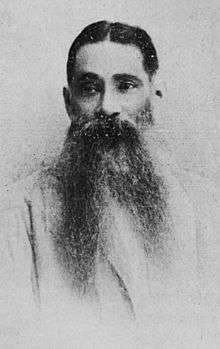Womesh Chunder Bonnerjee
| Womesh Chunder Bonnerjee | |
|---|---|
 Portrait | |
| Born |
29 December 1844 Calcutta, British India |
| Died | 21 July 1906 (aged 61) |
| Nationality | Indian |
| Alma mater |
Oriental Seminary Hindu School |
| Occupation | Lawyer |
| Known for | first president of Indian National Congress |
| Spouse(s) | Hemangini Motilal (m. 1859) |
Womesh Chunder Bonnerjee (or Umesh Chandra Banerjee by current English orthography of Bengali names) (29 December 1844 – 21 July 1906) was an Indian barrister and was the first president of Indian National Congress. He was the first Indian to contest the election for the British House of Commons although he lost the election. He made two unsuccessful attempts to enter the British parliament.
Early days
Womesh Chunder Bonnerjee was born on 29 December 1844 at Calcutta (now Kolkata), in the present-day state of West Bengal.[1] He studied at the Oriental Seminary and the Hindu School.[1] In 1859, he married Hemangini Motilal. His career began in 1862 when he joined the firm of W. P. Gillanders, attorneys of the Calcutta Supreme Court, as a clerk. In this post he acquired a good knowledge of law which greatly helped him in his later career. In 1864 he was sent to England through a scholarship from Mr. R. J. Jijibhai of Bombay[1] where he joined the Middle Temple and was called to the Bar in June, 1867.[2] On his return to Calcutta in 1868, he found a patron in Sir Charles Paul, Barrister-at-Law of the Calcutta High Court.[1] Another barrister, J. P. Kennedy, also greatly helped him to establish his reputation as a lawyer. Within a few years he became the most sought after barrister in the High Court. He was the first Indian to act as a Standing Counsel, in which capacity he officiated four times — 1882, 1884, 1886-67. In 1883 he defended Surendranath Banerjee in the famous contempt of court case against him in the Calcutta High Court. He was the fellow of Calcutta University and was the president of its law faculty[1] and often represented it in the legislative council.[2] He retired from the Calcutta bar in 1901.[1] His daughter Janaki Bonnerjee studied natural science, chemistry, zoology and physiology at Newnham College, Cambridge University.[3]
As president of Indian National Congress
He presided over the first session of the Indian National Congress held at Bombay in 1885[2] from 28 December to 31 December and attended by 72 members.[4] In the 1886 session held at Calcutta, under the presidency of Dadabhai Naoroji, he proposed the formation of standing committees of the Congress in each province for the better co-ordination of its work and it was on this occasion that he advocated that the Congress should confine its activities to political matters only, leaving the question of social reforms to other organisations. He was the president of the Indian National Congress again in the 1892 session in Allahabad[2] where he denounced the position that India had to prove her worthiness for political freedom.[5] He moved to Britain and practiced before the Privy Council.[2] He financed the British Committee of Congress and its journals in London.[2] In 1865 Dadabhai Naoroji founded the London Indian society and Bonnerjee was made its general secretary. In December 1866, Naoroji dissolved the society and formed East Indian Association.[6] When Bonnerjee became the Congress president Naoroji along with him, Eardley Norton and William Digby opened The Congress Political Agency, a branch of Congress in London.[6] He lived in Croydon and named his residence after his birthplace Khidirpur.[6] The Liberal party made him his candidate for the Barrow-in-Furness seat in 1892. Bonnerjee was defeated by Charles Cayzer, a Tory candidate. In the same elections Naoroji won the Finsbury Central constituency and defeated his nearest rival by a narrow margin of only 5 votes. Naoroji became the first Indian member of the British Parliament. In 1893, Naoriji, Bonnerjee and Badrubdin Tyabji founded the Indian Parliamentary Committee in England.[6]
References
- 1 2 3 4 5 6 Buckland, CE (1906). Dictionary of Indian Biography. London: Swan Sonnenshein & Co. p. 48.
- 1 2 3 4 5 6 Sayed Jafar Mahmud (1994). Pillars of Modern India, 1757-1947. APH Publishing. p. 19. ISBN 978-81-7024-586-5.
- ↑ Susheila Nasta (2012). India in Britain: South Asian Networks and Connections, 1858-1950. Palgrave Macmillan. p. 70. ISBN 978-0-230-39272-4.
- ↑ "Sonia sings Vande Mataram at Congress function". Rediff. 28 December 2006. Retrieved 23 August 2014.
- ↑ Lacy, Creighton (1965). The Conscience Of India – Moral Traditions In The Modern World, Holt, New York: Rinehart and Winston, p. 123
- 1 2 3 4 Faruque Ahmed. Bengal Politics in Britain. Lulu.com. pp. 24–25. ISBN 978-0-557-61516-2.
External links
| Preceded by (none) |
President of the Indian National Congress 1885 |
Succeeded by Dadabhai Naoroji |
| Preceded by Anandacharlu |
President of the Indian National Congress 1892 |
Succeeded by Dadabhai Naoroji |